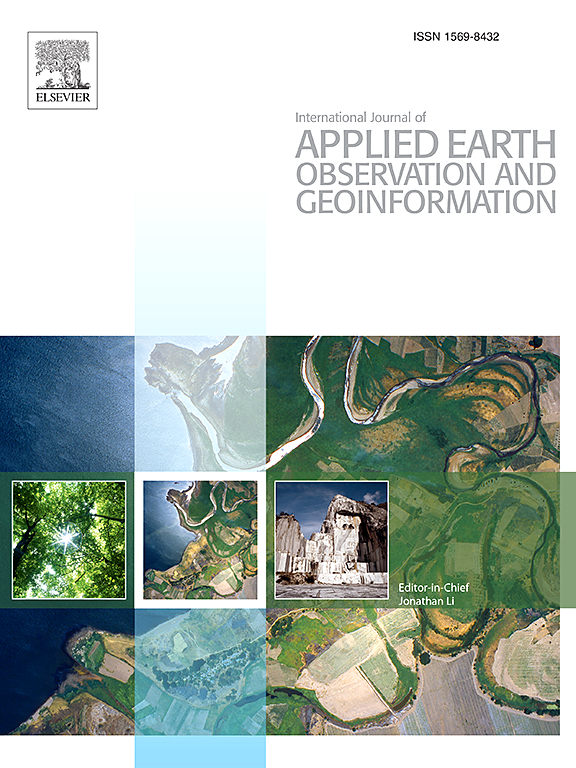A multi-source remote sensing-based geocommunication tool for global flood monitoring and management
IF 8.6
Q1 REMOTE SENSING
International journal of applied earth observation and geoinformation : ITC journal
Pub Date : 2025-07-02
DOI:10.1016/j.jag.2025.104701
引用次数: 0
Abstract
Global warming is expected to increase the frequency of extreme flooding, making rapid and accurate flood mapping crucial for effective risk assessment. Many governmental agencies and organizations are developing flood risk assessment tools; however, due to the lack of observational records, some rely on probabilistic generated data, uncalibrated simulations, or terrain-based methods, all of which are subject to various types of uncertainty. Although remote sensing provides valuable flood data with global coverage, single-source reliance is constrained by satellite revisit rates, resolution, weather conditions, and sensor limitations. To address these challenges, this study introduces a user-friendly application on the Google Earth Engine (GEE) platform that enables near-real-time global flood mapping using a multi-source remote sensing approach. By leveraging optical and SAR imagery, the App ensures improved water detection accuracy and supports all-weather and day/night monitoring. Our results show SAR and optical flood inundation maps agree up to 80 %. Beyond flood mapping, the tool leverages GEE datasets to extract multi-disciplinary information, such as population exposure and affected residential, urban, and cropland areas, to support timely decision-making. For example, during the Sylhet, Bangladesh flood, the tool identified over 300,000 people potentially affected and approximately 600 km2 of cropland inundated. This research presents one of the first global-scale, rapid, multi-source flood mapping tools tailored to both expert users and non-expert decision-makers. It offers a practical solution to current data limitations and supports more informed emergency response, planning, and climate resilience efforts to foster communication across scientific, policy, management, and operational communities.
基于多源遥感的全球洪水监测与管理地理通信工具
预计全球变暖将增加极端洪水的频率,因此快速准确的洪水测绘对于有效的风险评估至关重要。许多政府机构和组织正在开发洪水风险评估工具;然而,由于缺乏观测记录,一些依赖于概率生成的数据、未校准的模拟或基于地形的方法,所有这些都受到各种类型的不确定性的影响。尽管遥感提供了覆盖全球的宝贵洪水数据,但单一来源的依赖受到卫星重访率、分辨率、天气条件和传感器限制的限制。为了应对这些挑战,本研究在谷歌地球引擎(GEE)平台上引入了一个用户友好的应用程序,该应用程序可以使用多源遥感方法实现近实时的全球洪水制图。通过利用光学和SAR图像,该应用程序确保提高水检测精度,并支持全天候和昼夜监测。我们的研究结果表明,SAR和光学洪水淹没图的一致性高达80%。除了绘制洪水地图,该工具还利用GEE数据集提取多学科信息,如人口暴露和受影响的住宅、城市和农田面积,以支持及时决策。例如,在孟加拉国Sylhet洪水期间,该工具确定了30多万人可能受到影响,大约600平方公里的农田被淹没。本研究提出了首个针对专家用户和非专家决策者量身定制的全球规模、快速、多源洪水制图工具之一。它为当前的数据限制提供了切实可行的解决方案,并支持更明智的应急响应、规划和气候适应能力工作,以促进科学、政策、管理和业务界之间的沟通。
本文章由计算机程序翻译,如有差异,请以英文原文为准。
求助全文
约1分钟内获得全文
求助全文
来源期刊

International journal of applied earth observation and geoinformation : ITC journal
Global and Planetary Change, Management, Monitoring, Policy and Law, Earth-Surface Processes, Computers in Earth Sciences
CiteScore
12.00
自引率
0.00%
发文量
0
审稿时长
77 days
期刊介绍:
The International Journal of Applied Earth Observation and Geoinformation publishes original papers that utilize earth observation data for natural resource and environmental inventory and management. These data primarily originate from remote sensing platforms, including satellites and aircraft, supplemented by surface and subsurface measurements. Addressing natural resources such as forests, agricultural land, soils, and water, as well as environmental concerns like biodiversity, land degradation, and hazards, the journal explores conceptual and data-driven approaches. It covers geoinformation themes like capturing, databasing, visualization, interpretation, data quality, and spatial uncertainty.
 求助内容:
求助内容: 应助结果提醒方式:
应助结果提醒方式:


